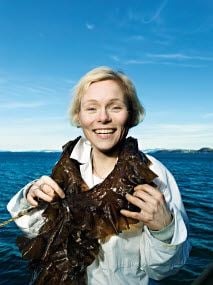
|
|
Jorunn Skjermo at SINTEF cultivates kelp. Photo: Geir Mogen. |
Senior scientist Jorunn Skjermo is the primus motor for these studies, together with her colleague Kjell Inge Reitan. Their driving force is the idea that Norway should develop fuels based on cultivated kelp. “A raw material that could give the world sustainable biofuels,” as Skjermo puts it.
Jorunn Skjermo is a biologist. She already has long experience of using biomass from algae in research projects that have ranged from feeding fish fry to hunting for microalgae that contain substances that can stimulate the immune system. In its efforts to cultivate macroalgae (seaweed), SINTEF has the backing of both the Research Council of Norway and StatoilHydro.
“How on earth can kelp be turned into fuel?”
“Kelp contains a lot of carbohydrates. Many microorganisms, such as yeasts, can convert such substances into bioethanol, just as when corn or potatoes are turned into spirits. Ethanol is simply what we usually call alcohol.
“All over the world, vehicles are being manufactured with engines that have been modified to burn a mixture of 85% ethanol by volume and 15 percent petrol. Micro-organisms can also form butane, another fuel from kelp.
“The simplest method is to use bacteria of the sort that we find in the stomachs of cows and pigs, and persuade these to break the kelp down to biogas that can be used for heating or, in an upgraded version, as a fuel in heavy vehicles and ships.”
“How did you come to land on kelp, of all the plants that could fuel vehicles?”
“Liquid biofuels have met a lot of negative criticism because current production of bioethanol and biodiesel is based on vegetable products that could have been used for food, or that are produced on land that could have been used to cultivate food. Many countries, including Norway, have raised the alarm about this trend.
“Cultivating kelp will supply us with fuels without using food as a raw material, and without taking up either good soil or freshwater resources. And Norway enormous areas that are very suitable for cultivating kelp. Our coastline, including all its islands, is twice as long as the Equator. Norway’s economic zone is twice as large as the land area of Sweden.”
“But can it pay to produce fuel from kelp?”
“We have already come quite a long way with studies that will clarify what such production lines would cost, and on the basis of what we seen so far, we believe that they would be at least as good economically as production based on timber – which is another area of research into which Norway is putting a lot of effort.”
“Well, kelp contains carbon. Won’t fuel based on kelp increase the greenhouse effect?”
“Kelp absorbs the CO2 that is dissolved in water, and this is released when the fuel is burned. By cultivating it, this becomes a zero-sum game, whether we are talking about kelp or trees as raw materials for fuel. At the same time, global CO2 emissions will sink, the more we replace fossil energy with biofuels.”
“Why cultivation? Can’t we simply harvest “wild” kelp?”
“Norway has been trawling for kelp commercially on the coast for 35 years. Every year, this country harvests about 170,000 tonnes, most of which is giant kelp that is used for industrial applications of alginates – substances that have the ability to thicken and stabilise products and are therefore used in a wide range of food products.
“The quantity of kelp harvested in Norway is kept at a sustainable level and cannot be increased just like that. Any outtake over current levels will have to be based on cultivation.”
“How do we cultivate kelp?”
“Both seaweed and kelp are cultivated in coastal area all over the world. Annual global production is 14 million tonnes of cultivated kelp. Most production is in Asia, and most of it goes to food.
“Cultivation begins by stimulating kelp plants to produce sex cells (spores) in an onshore system. After fertilisation, the “newborn” plants (microscopic embryos) attach themselves to ropes, which are kept on shore until the embryos are a few centimetres long. The ropes are then placed in the sea, where they hang vertically from long floating lines. At this stage, the kelp plants make use of what is available of food and light.”
“What will be the focus of SINTEF’s cultivation experiments in the future?”
“Our experiments will clarify which species of kelp are most suitable for cultivation in northern waters.
“We follow up the plants carefully in each farm in order to find out how much they grow and how much biomass can be harvested and used to produce biofuels. Our studies should provide an answer to how closely spaced the hanging ropes can be, which current conditions are best, at what depth the grow fastest, and how long the ropes need to hang in the sea before the kelp can be harvested. A little further ahead in time, we aim to develop technology that will make kelp cultivation at our latitudes as reasonably priced as possible.”
Svein Tønseth
Mini CV for Jorunn Skjermo
• PhD in aquaculture, 1996.
• Joined SINTEF Fisheries and Aquaculture as senior scientist.
• Has taken initiative to, and led, national and international projects for the Research Council of Norway, the EU Commission and StatoilHydro, among others.
